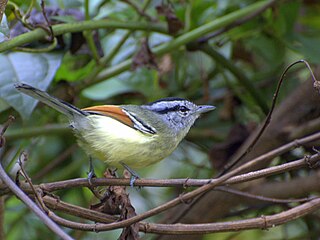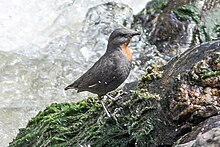
The American dipper, also known as a water ouzel, is a semiaquatic bird species native to western North America.

Dippers are members of the genus Cinclus in the bird family Cinclidae, so-called because of their bobbing or dipping movements. They are unique among passerines for their ability to dive and swim underwater.

The white-throated dipper, also known as the European dipper or just dipper, is an aquatic passerine bird found in Europe, Middle East, Central Asia and the Indian Subcontinent. The species is divided into several subspecies, based primarily on colour differences, particularly of the pectoral band.

The white-capped dipper is an aquatic passerine found in South America. It is a small black bird with white spots. It is found in the Andes from northern Bolivia, through Peru, Ecuador, Colombia to northwest Venezuela.

The brown dipper, also known as Pallas's dipper, Asian dipper or the Asiatic dipper, is an aquatic songbird found in the mountains of the east Palearctic. It is a thrush-like bird with a cocked tail. Its plumage is chocolate-brown with a slightly lighter coloured back and breast. At 22 cm (8.7 in) and 87 g (3.1 oz), it is the largest of the dippers. This species, which is not often seen, is found at medium to low elevations where mountain streams flow.

The tit-like dacnis is a small neotropical passerine bird found in southern Ecuador and Peru. In Spanish, it is known as Azulito Altoandino. It is found in Andean montane scrub forests from 3000 m to 4600 m elevation.

Myiarchus is a genus of birds in the tyrant flycatcher family Tyrannidae. Most species are fairly similar in appearance and are easier to separate by voice than by plumage.

Haplospiza is a small genus of birds in the tanager family Thraupidae. Formerly classified in the bunting and American sparrow family Emberizidae, more recent studies have shown it to belong in the Thraupidae. Its two members breed in subtropical or tropical moist forest in Central and South America. They are often associated with bamboo.

The black-goggled tanager is a species of bird in the family, Thraupidae. It is the only member of the genus Trichothraupis. It is found at low levels in forest and woodland in a large part of eastern and southern Brazil, eastern Paraguay and far north-eastern Argentina, with a disjunct population along the East Andean slope in Peru, Bolivia and far north-western Argentina. While generally common and widespread, and consequently considered to be of least concern by BirdLife International and IUCN, the population associated with the Andes is relatively local and uncommon.

The chestnut-headed tanager is a species of bird in the tanager family Thraupidae this is found in the Atlantic Forest of southeast Brazil, eastern Paraguay and far northeastern Argentina. It was formerly the only member of the genus Pyrrhocoma but is now placed in Thlypopsis.
The dusky long-tailed cuckoo is a species of cuckoo in the family Cuculidae. It is found in forests in Central Africa. The IUCN has assessed it as a least-concern species.

The white-bearded antshrike is a Vulnerable species of bird in subfamily Thamnophilinae of family Thamnophilidae, the "typical antbirds". It is endemic to Argentina and Brazil.

The black-tailed cisticola is a species of bird in the family Cisticolidae found in Angola and Democratic Republic of the Congo. Its natural habitat is dry savanna and the canopy of smaller trees. It forages for insects both in the canopy and on the ground.

The rufous-margined antwren is an insectivorous bird in subfamily Thamnophilinae of family Thamnophilidae, the "typical antbirds". It is found in Argentina, Brazil, and Paraguay.

The star-throated antwren is an insectivorous bird in subfamily Thamnophilinae of family Thamnophilidae, the "typical antbirds". It is endemic to southeastern Brazil.

The purple-throated sunbird, is a species of bird in the family Nectariniidae. Its natural habitats are lowland tropical forests and subtropical or tropical mangrove forests of Maratua and the Philippines.

The mourning sierra finch is a species of South American bird in the tanager family Thraupidae. It is the only member of the genus Rhopospina.

Cabanis's spinetail is a species of bird in the Furnariinae subfamily of the ovenbird family Furnariidae. It is found in Brazil, Bolivia, and Peru.

The dusky-throated antshrike is a species of bird in subfamily Thamnophilinae of family Thamnophilidae, the "typical antbirds". It is found in Bolivia, Brazil, Colombia, Ecuador, French Guiana, Guyana, Peru, Suriname, and Venezuela.

The orange-headed tanager is a species of bird in the family Thraupidae. Native to South America, it is found in Argentina, Bolivia, Brazil, Colombia, Ecuador, Paraguay, Peru, and Venezuela, where it inhabits successional vegetation, cerrado, riparian forest, shrub, brush, and open woodland. Males of the species have sandy-gray upperparts, cinnamon to buff underparts, white on the center of the lower breast, belly, and tail, and rufous-orange and yellow heads. Females are similar but duller.





















